MENUMENU
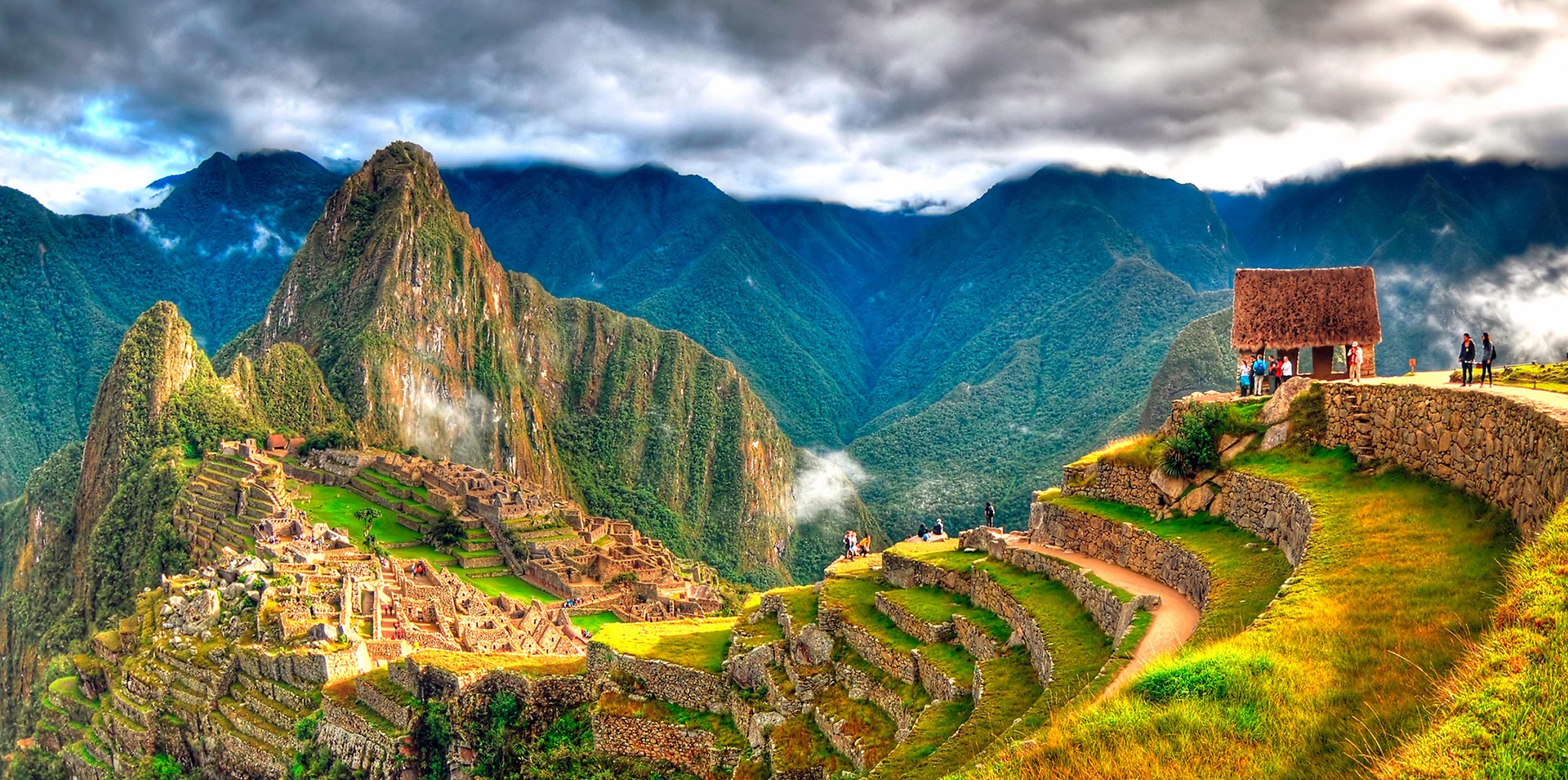
Reading time: 29 mins
For years, Peru has been one of the most mesmerizing and fascinating destinations in South America. Loaded with impressive views, millennia-old culture, and the interesting contrasts that it displays between modernity and archeology, travel to Peru is a sure bet for all those looking to experience something truly complete and impressive in the region.
So, if Peru’s in your sights but you’re still a little daunted by just how many things you need to know before venturing to this country of wonders, this blog will help you resolve exactly that! Follow along as we present you with 14 things you need to know before traveling to Peru!
“What type of visa do I need to travel to Peru? What are the requirements for visiting Peru?” You might ask yourself…
You can breathe easy knowing that, to travel to Peru, you’ll only need your energy, curiosity, and your passport! To enter the country, citizens from the American and European continent do not need to apply for a tourist visa. In fact, you’ll automatically get one the moment you enter Peru, which will allow you to travel freely throughout the country for a maximum 90 days. However, to avoid any inconveniences for your journey back, it’s always recommended that visitors have their return ticket bought and handy.
If you have an official photo ID or documentation from countries such as Argentina, Bolivia, Brazil, Chile, Colombia, Ecuador, Paraguay, and Uruguay, then you can enter Peru without having to present your passport. Otherwise, you will definitely have to bring your passport with you! Remember that it is highly important that make you make sure your passport has at least six months of validity (before your return date from Peru).
Tip for travelers: Keep your identification documents safe at all times! As you’re experiencing all of the wonders that Peru has to offer, try and keep a color copy of them (either your passport or official ID) with you at all times, making sure to leave all of the original important documents in the safe deposit box at your hotel.
Spanish is the main language in Peru. However, you may very well encounter Peruvians that speak English, particularly in commercial establishments, restaurants, and/or other touristic sites. If the language might a barrier for you, then opting for a Travel Agency is oftentimes an excellent option. Travel Agencies, in addition to including accommodation options, culinary delights, and first-class tours, also include a bilingual guide that will accompany you along the way and help you with any language barriers you may encounter.
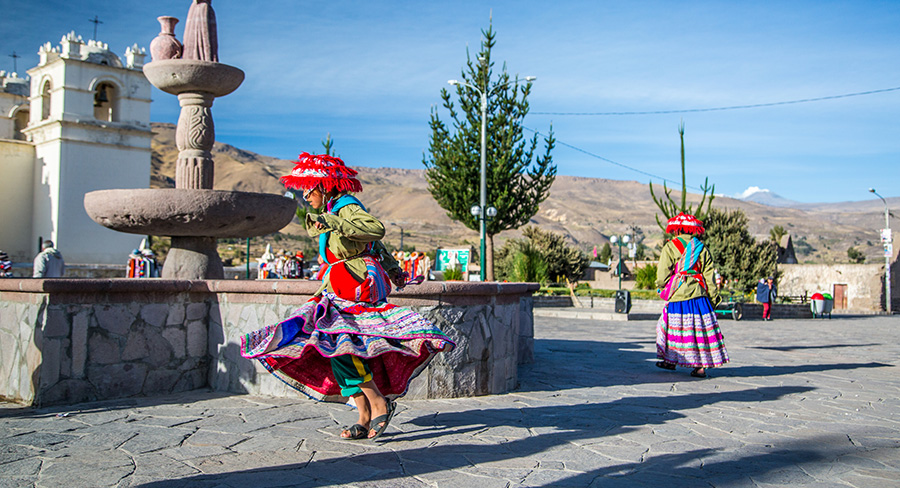
Girl in traditional dress playing in Yanque, Peru
If you’re ready to travel to Peru, don’t forget to change your money! The currency that’s used in Peru is known as the “sol.” Granted, certain establishments throughout the country do accept US dollars and Euros, but nevertheless, we do recommend changing your money to Peru’s local currency upon arriving at the airport in Peru. This way, you’ll be able to benefit from a better overall exchange rate, given said rate is established by the local authorities.
Certain establishments in Peru also accept international credit and debit cards (Visa, American Express, and Mastercard, among others). However, you should always keep in mind that such cards can only be used at major establishments. If you’re looking to buy handicrafts at the markets, take a taxi, or eat at a small, typical restaurant, then be prepared to keep that plastic in your wallet and take your “soles” out for a spin instead.
Peru’s timezone is GMT-5, meaning that if it’s 10 a.m. in Peru, then:
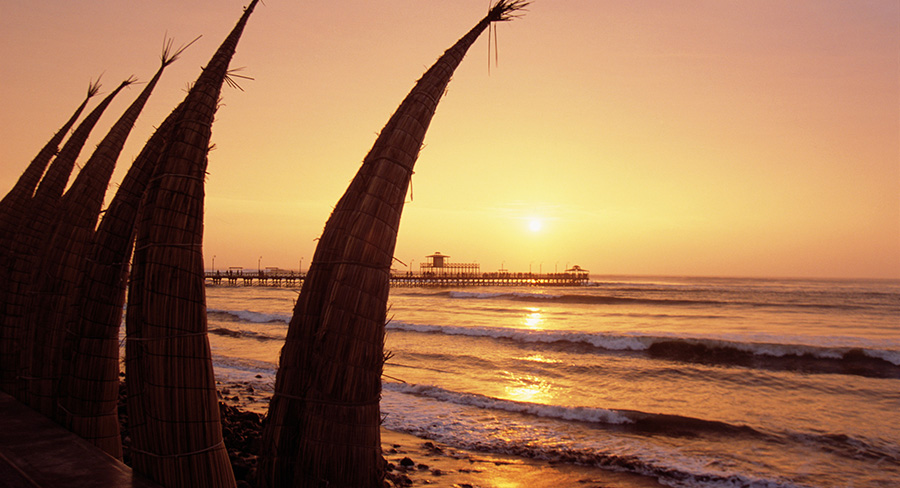
Sunset over Trujillo Beach in Peru
Peru is approximately 496,224 mi² (1,286,216.20 km²) long, with an altitude that ranges between -111 feet (-34 meters) below sea level (in the Bayovar Depression, which is Peru’s lowest point) all the way to 22,204 feet (6,768 meters) above sea level at the top of the massive, snow-capped Huascaran mountain. Given Peru’s length and its range of altitude and ecosystems, temperatures in the country can vary tremendously, and thus planning your trip will need to take different regions into consideration.
The Northern Coast
Temperatures during summertime along the coast oscillate between 84 °F (29 °C) and 95 °F (35 °C). It’s during this season, which typically occurs between November and April, is also regarded as the rainy season, so don’t forget to pack your umbrella!
Between the month of May and October, the temperature drops a little and the rains die down. Temperatures during this period range from 66 °F (19 °C) to 82 °F (28 °C).
Tip for travelers: If you plan on visiting this region, don’t pass up the chance to visit the beaches of Zorritos, Punta Sal, Mancora, Vichayito, Los Organos, Nuro, Pimentel and Huanchaco. Additionally, from the end of July until the end of October, you’ll probably be lucky enough to witness humpback whales swimming and playing along the Peruvian coast! Other places worth visiting along the Northern Coast of Peru are Trujillo and Chiclayo have numerous and cool visitor sites. Trujillo, for instance, offers Huaca del Sol y la Luna, Chan Chan, the El Brujo Archeological Site, and Chicama. Over in Chiclayo, you won’t want to miss the Museum of Tumbas Reales (Royal Tombs) and Huaca Rajada.
The Central & Southern Coast
During the summer months (typically between October until March) in this region of the coast, visitors can expect to have temperatures oscillating between 66 °F (19 °C) and 82 °F (28 °C), which is slightly cooler than the northern coastal region of Peru. During wintertime, temperatures can get as low as 57 °F (14 °C) and reach up to 64 °F (18 °C), often times with fog present.
Tip for travelers: If you plan on visiting this region, don’t pass up the chance to visit Lunahuana, Chincha, Ancon, Paracas, Ica, and Nazca.
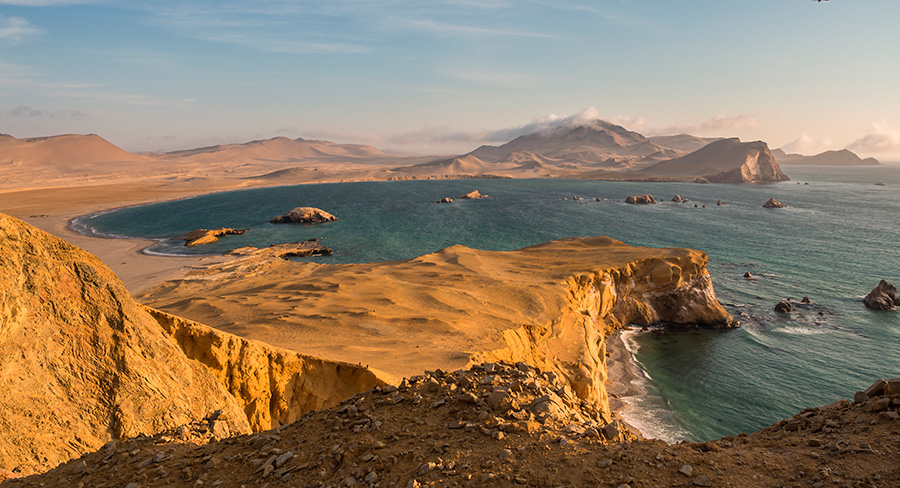
Coast and cliffs in Paracas, Peru
Up above, in the Andean region of Peru, sunny and rainy days are found between the months of October and March, when temperatures in this region are affected by a combination of both altitude and geography. Taking this into consideration, the weather during the aforementioned months will often oscillate between 66°F (19°C) and 82°F (28°C). Winter, which lasts from April until September, brings with it temperatures that range from 57 °F (14 °C) and 64 °F (18 °C).
Something else you’ll want to keep in mind is that, at night, temperatures in this region will often drop to a chilly 35 °F (2 °C).
Tip for travelers: If you plan on visiting this region, don’t pass up the chance to visit Cuzco, Arequipa, the Mountain of 7 Colors, Puno (and Titicaca Lake), Colca Canyon, and Machu Picchu.
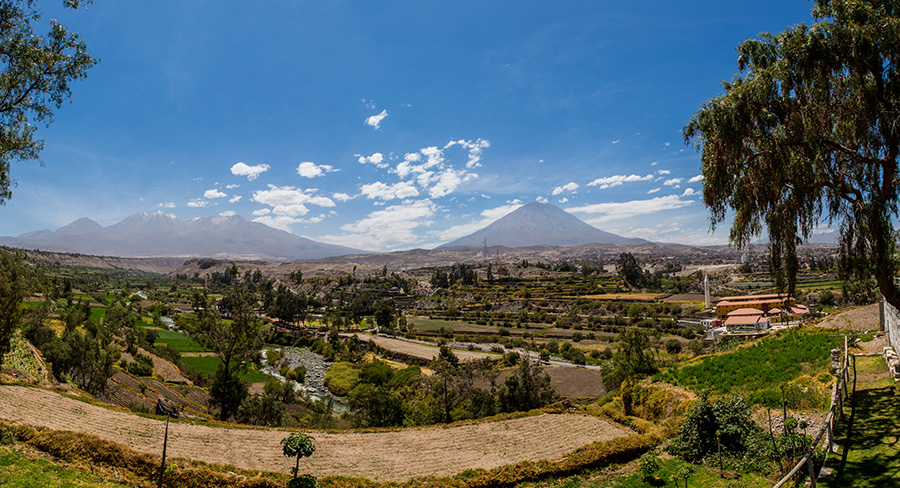
Vineyards landscape in Arequipa, Peru
If you choose to visit this region, then you can expect to find a humid climate that hovers between 62 °F (17 °C) and 95°F (35°C). Rains are also quite a common characteristic of this region. However, during the months of May to August, rainfall tends to diminish.
Tip for travelers: If you’re planning on visiting this region, definitely consider visiting Tambopata, Iquitos, Manu, and Chachapoyas.
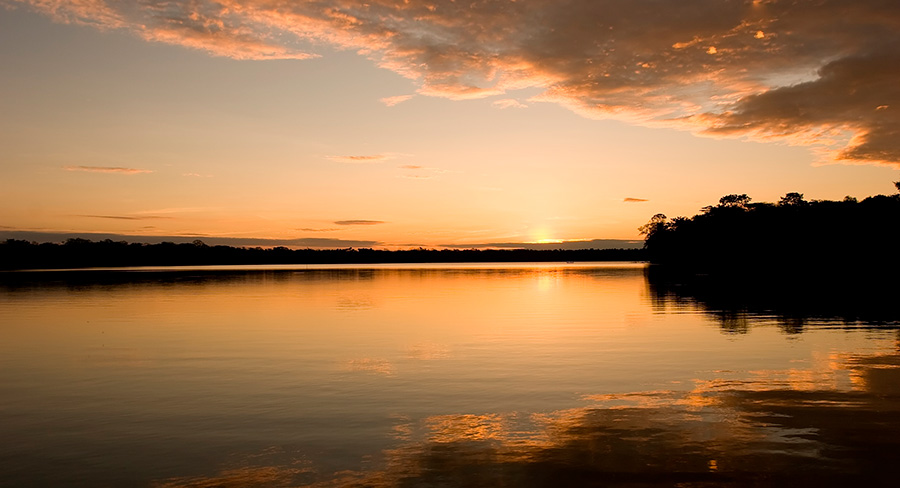
Sandoval Lake in Tambopata, Peru
Voltage in Peru is 220 volts, with a frequency of 60 hertz, which is almost double that of what the U.S. uses (120 volts).
With respect to electrical outlets, there are two kinds in Peru: Type A and Type C. Type A are those that are commonly seen in the US and Canada, consisting of two parallel flat prongs, one being slightly larger than the other. Type C are those that have rounded prongs and are often seen in European countries. If you’re planning on visiting Peru, you’ll most likely want to take an adaptor with you (voltage and connector converter, if possible), given electrical outlets are only compatible with the aforementioned types.
If you’re going to enter the country of Peru from Angola, Brazil, Congo, and/or Uganda, then you’ll need to have a certificate of having received your Yellow Fever vaccine. On the other hand, if you’re planning on traveling to the Amazon in Peru, then we highly recommend getting this same vaccine at least 10 days before beginning your trip (so that it’s more effective). Better safe than sorry!
If neither of the above is the case with respect to your trip, then there’s nothing you need to worry about! You won’t be needing any type of vaccine to enter Peru.
Despite there being no medical insurance requirements to enter Peru, it’s always advised (with any international destination in the world, really) to carry medical insurance with you. This way, you’ll have that extra peace of mind should any unexpected incident arise.
And speaking of unexpected incidents…
Seriously. Avoid doing so at all costs. Despite the water in Peru being potable, it’s more likely than not that, upon drinking tap water, your stomach will find itself in a rather unpleasant state. Don’t worry though: bottled, mineral, and/or boiled/filtered water is provided in virtually all inhabited areas of Peru.
Peru offers its visitors a sky-high experience in every sense of the word. If you plan on visiting the highlands of the country, which are traversed by the majestic Andean Cordillera, you’ll want to keep the following in mind to avoid altitude sickness.
Generally, altitude sickness begins to appear at around 7,874 feet (2,400 meters) above sea level due to a lack of oxygen. It’s much more common in people that are under the age of 50 and that have resided in coastal areas that are lower than 2,950 feet (900 meters) above sea level. Common symptoms include dizziness, headache, and fatigue.
Peru, as we mentioned previously, has rich and highly varied elevations. What’s more is that several of its most important and popular tourist attractions are Cuzco, Machu Picchu, and Titicaca Lake, which are found at 11,151 feet, 7,940 feet, and 12,500 feet (3,399 meters, 2,420 meters, and 3,812 meters) above sea level, respectively.
The biggest recommendation for avoiding altitude sickness and preventing it from ruining your vacation is to properly acclimatize. The first step to do this is by starting your trip in a city that isn’t too high up, such as Lima, and then heading upwards gradually. Additionally, you’ll want to avoid exerting yourself too much physically, avoid eating too much, drinking too much alcohol and/or smoking in excess.
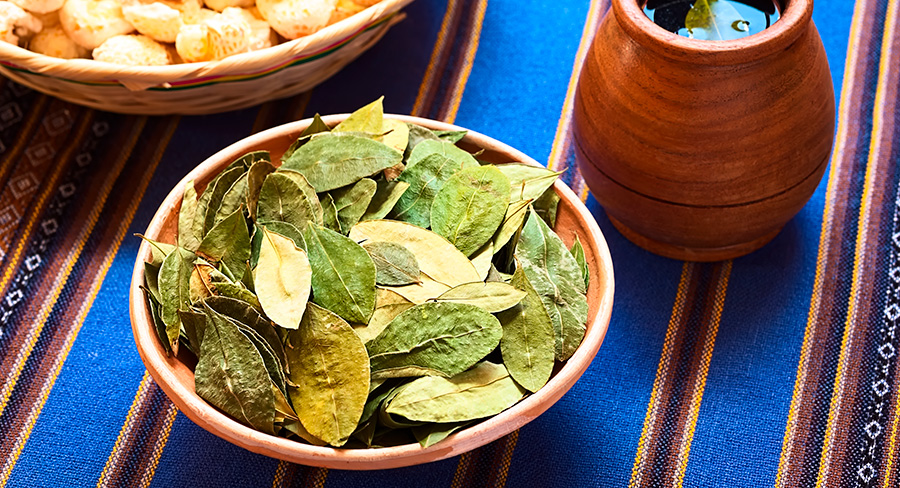
Coca leaves and tea in Peru
Tip for travelers: Throughout the centuries, Peruvians have relief on chewing coca leaf or drinking coca tea to lessen and prevent the symptoms that arise as a result of altitude sickness. So if anyone offers you these remedies, don’t worry!
To move around from city to city, one of the most popular options tends to be by bus. Depending on how much you’re willing to pay, these buses will often come equipped with individual TV screens, recliner seats (some of which become full-out beds), and included meals. However, something else you’ll have to keep in mind is that these buses cover long distances. And by long we mean that a trip from Lima to Cuzco, for instance, can take up to 21 hours.
Another option, which is much more viable yet relatively pricier, is hopping on a national/domestic flight. Following the previous example, a trip from Lima to Cuzco via airplane takes approximately 1 hour and 15 minutes to complete.
And so, keeping all that in mind, what you’ll have to consider when you’re getting ready to move between cities is whether you’d like to save money and lose some rather precious time or spend a little more and have more time to enjoy everything Peru has to offer.
Tip for travelers: If you’re traveling through Peru, but your timeframe isn’t too flexible and you’d rather not get caught up in the logistical complexities of organizing your trip from zero, then we recommend booking through a Travel Agency! You can rest assured that Travel Agencies will take care of virtually everything with respect to your trip – accommodation, transportation, activities, and even meals! All you have to do is choose the package that best suits your interests or simply provide us with your interests and we’ll create a package for you!
Transportation in within the bigger cities can be quite an adventure for most visitors! Public buses, which oftentimes have pre-established routes that will get you relatively close to the places you want to visit, have a fee of 1.51 soles (approximately $0.45 US dollars) for each trip. By hopping aboard this means of transportation, you’ll get a true sense of what the day-to-day life is like for Peruvians at a very convenient price. However, you’ll have to put up with a rather crowded space, especially at rush hour, and you’ll also want to keep a watchful eye on your belongings.
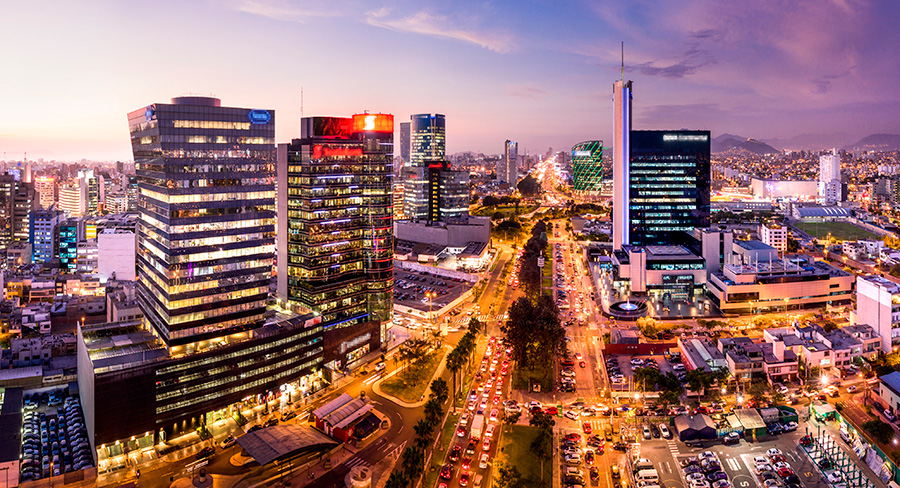
Sunset over the San Isidro District in Lima, Peru
Another option and popular means of transportation are taxis. You can find dozens of them by simply walking out onto the sidewalk of any major city, making for an extremely convenient way of organizing your trip throughout the city in a fast and easy manner. Based on the rates that are regulated by the Peruvian government, the cost of taking a taxi has a starting fare of 7.10 soles (approximately $2.10 US dollars) and, from there on, will have an added cost of 5 soles (approximately $1.48 US dollars) per 1 kilometer/0.6 miles driven.
That being said, it’s worth mentioning that, as in many other parts of the world, you might find yourself with taxi drivers that are looking to earn more for the ride. Our recommendation in the event that such scenarios do arise is simply: don’t be afraid to negotiate. In cities like Lima, your taxi driver will give you an estimated cost for the entire trip. However, with the right words, you might be able to lower the cost of a trip by 1 to 3 soles.
Another viable option that’s available in numerous cities in Peru is Uber. This App, as many readers may already know, allows you to request a taxi through your smartphone and designate from which point you’d like to be picked up and where you’d like to be dropped off. Before requesting your ride, the App calculates the value of your journey and allows you to pay either in cash or directly with your credit and/or debit card through the App itself.
Very safe. However, upon enjoying the beauty of Peru, you’ll want to take into consideration all of the same security and precautionary measures that you would in any other major city in the world. Try not to walk alone in faraway and isolated areas of the country, keep your belongings safe, and always keep an eye on your surroundings. Peruvians are charming and highly welcoming people, known for their hospitality and friendliness, so you won’t have to worry about much!
Absolutely! As we mentioned earlier in this blog, Peru is a large country with a wide array of things to do and discover hiding in just about every corner. Whether it’s through a Travel Agency or on your own, the most recommendable thing to do is to plan everything want to see, and every place you want to visit.
Additionally, you’ll also want to keep in mind that train and entrance tickets to/from Machu Picchu are things that you’ll need to buy months in advance. You wouldn’t want to have the unfortunate experience of finally getting to Machu Picchu, only to find that all tickets to this majestic archeological site are sold out! Also worth keeping in mind (as we mentioned earlier) is the fact that transportation logistics can be a rather complicated thing, depending on how you choose to go about.
By planning your trip well in advance – and keeping your timeframe in mind, points of interest, accommodation options, and more – you’ll be able to optimize your time in the country much better and, ultimately, have a more enjoyable experience in Peru!
A country as diverse as Peru is capable of offering each and every traveler exactly what they’re looking for. Whether it be a moment (or days) of peace surrounded by spectacular landscapes or reveling in the excitement of traversing across the highlands, this country is exactly what you’re looking for.
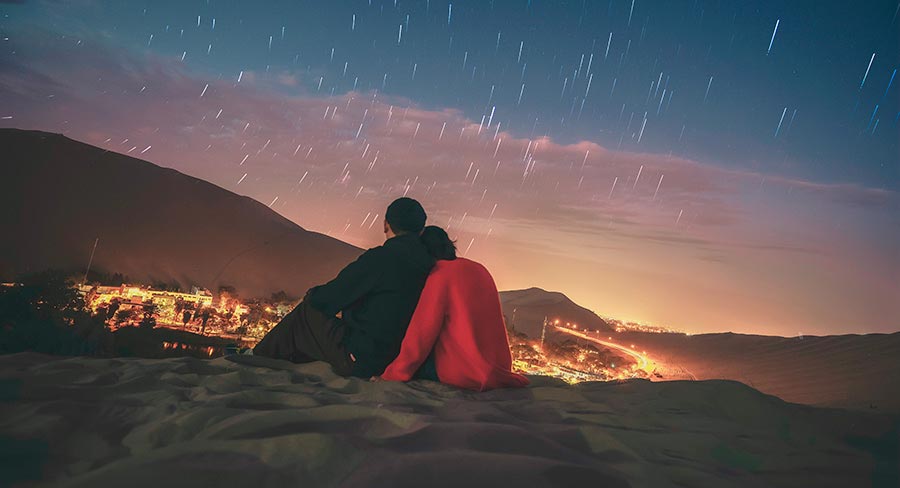
Couple admiring the stars in Huacachina, Peru
If your idea of a vacation in Peru entails complete and utter relaxation and not all that much of a focus on physical activities, then destinations in Peru such as Lima, the Sacred Valley, and Puno offer accommodation options that are equipped with a spa, spaces (and instructors!) for practicing yoga, and majestic views that you’ll get to revel in with a cocktail in hand. Additionally, these cities offer low-exertion activities such as casual walks and/or boat rides.
If Peru could shine in just one area of tourism, it would probably be the adventure tour options it offers. Exciting activities in this country abound in all their forms. Paragliding and surfing, for example, are popular activities to partake in while in Lima. Kayaking sports can be done in iconic places such as the turquoise waters of Paracas or up high at Lake Titicaca next to Puno. Zip-lining along the gorgeous landscapes of the Sacred Valley, or Expedition Cruises through the Amazon is just a small number of all the activities a true adventurer wouldn’t want to miss out on while in Peru.
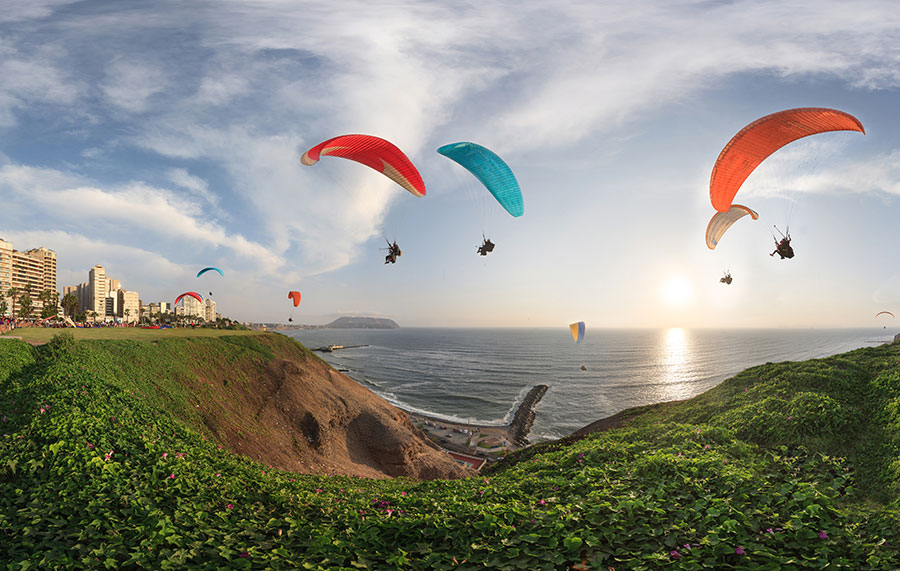
Paragliding in Lima’s coastline, Peru
All that being said, perhaps the cherry on top of this pie of adventure activities in Peru is, without argument, hiking along the Inca Trail to Machu Picchu. This adventure tour in Peru presents a majestic and exhilarating walk down millennia-old trails that the Inca civilization once used as a means of connecting its empire. Currently, this dense network of trails spans the countries of Peru, Colombia, Ecuador, Bolivia, Argentina, and Chile. Nevertheless, perhaps the most well-known of these trails (called “The Classic Trail”) is the one that takes 4 days to complete and begins from Kilometer 88 on the Cuzco-Quillabamba railway, with the glorious citadel of Machu Picchu awaiting at the very end as the grand prize.
The Inca Trail requires a fitness level that sits between moderate and high, given the conditions of the trail itself. Firstly, the total distance that you’ll have to traverse is 27 miles (43 kilometers) along a trail that is rustic, to say the least – patches are somewhat paved, but other patches consist of raw and uneven earth. Secondly, you’ll have to take altitude into consideration, as certain stretches of this trail will take you up to 13,779 feet (4,200 meters) above sea level! As we explained earlier in this blog – and depending on the speed at which you ascend and the physical shape that you’re in – altitude sickness may occur.
All that being said, it’s worth saying that following in the footsteps of the millennial-old Incan civilization is an experience that is undoubtedly worth it. The wide variety of ecosystems you’ll get to witness, the connection with nature you’ll have, and the visitor sites you’ll come upon along the way make the whole trek an experience of a lifetime. If you’re looking to embark on this adventure, remember to acquire your Inca trail hiking permit via a reputable Travel Agency and to hire a certified and authorized guide that will assist you with getting there.
Caption: Peru Fun Fact: To this day, archeologists around the world are astounded by how the Inca Trail in Peru was built. In spite of all the seismic activity that has plagued certain parts of the trail, the passage of time nor the force of nature has managed to affect or ruin these millennia-old trails!
Peruvian cuisine draws in foodies from all over the world, due in large part to the sheer variety of ingredients that the country incorporates into its dishes. Lima, specifically, tends to be regarded as the “culinary hotspot” of Peru, with dishes that primarily focus on being a fusion of Amerindian, Spanish, African, Asian, and Italian influences; several of which come together in platos criollos (“creole dishes”). Given the exotic medley of flavors available here, it’s no small wonder many visitors come to visit Lima for the food alone.
Peru Fun Fact: Over 4,000 varieties of native potatoes grow in Peru! So don’t be surprised to see this as the de facto culinary staple. It is almost always offered as a side order for just about everything.
When it comes to diet in Peru, visitors can expect to see meat in all its forms being offered at just about every single restaurant. Chicken, pork, sheep, beef, guinea pig, and even llama and alpaca meat are typical options. Fish is also immensely popular, given this tends to be a key ingredient in Peru’s renowned ceviche (seafood cocktail) which is prepared by marinating seafood in lime juice.
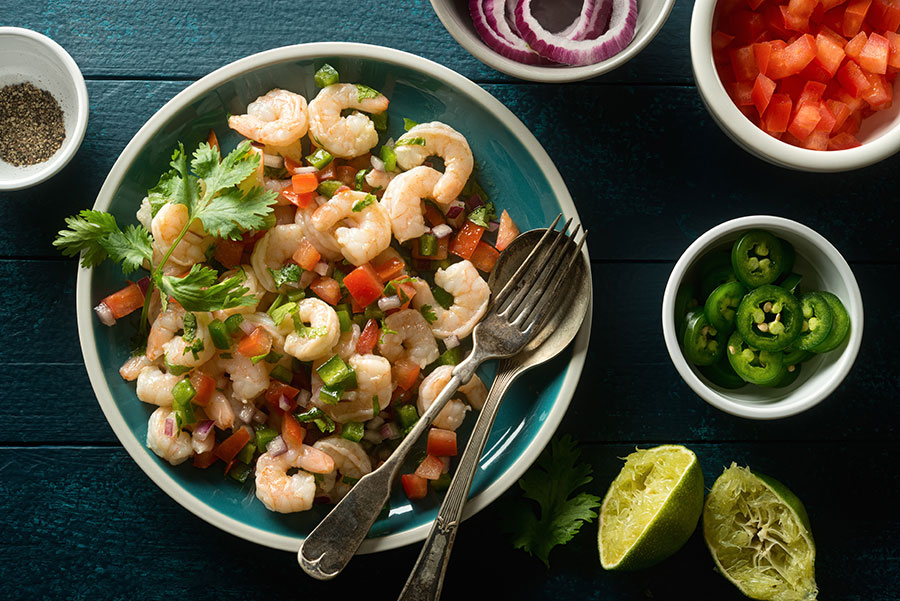
Traditional seafood in Peru
Vegetarian restaurants, on the other hand, are available in major cities, but keep in mind that they are rather rare.
Tip for travelers: Be wary of buying food – principally seafood – from street vendors, as sanitation and cleanliness are sometimes questionable at such establishments.
Peru is a country made up of people that are teeming with ancestral pride and, consequently, tourists are warmly welcomed to the plethora of visitor sites and cities in Peru. This pride (that’s evident and projected by Peruvians) mainly takes root in the country’s rich history of having served as the hub of both the Incan and Hispanic empires.
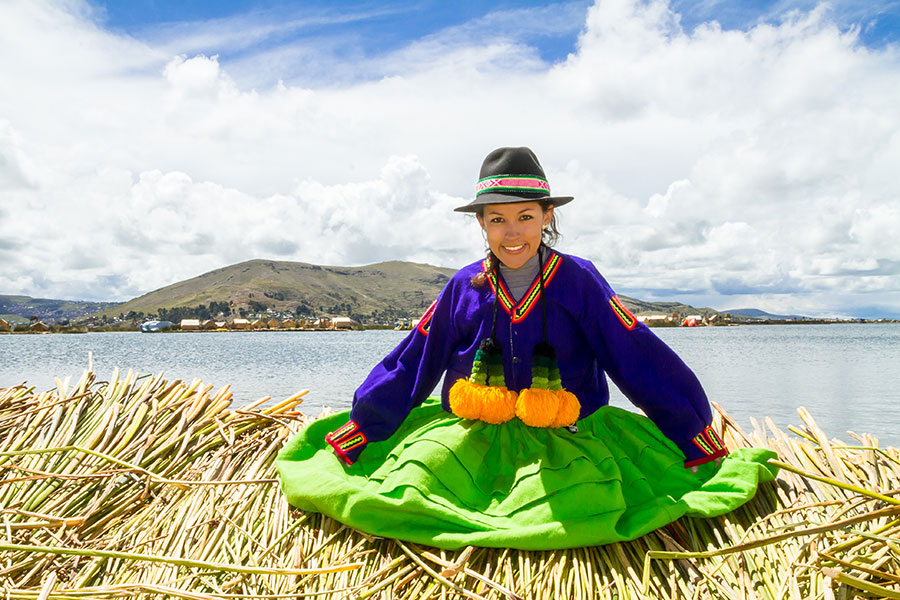
Peruvian girl in traditional dress
Vestiges of each respective empire are seen throughout the cities and surrounding regions, even manifesting itself in (as mentioned previously) the culinary offerings; but also in the numerous artisanal markets and shops throughout the country, where visitors will get to see millennia-old traditions and skills used in the production of unique wares and handicrafts.
The spirit of both these empires lives on in the daily lives of many Peruvians, making for a timeless and near-enchanting spectacle that will leave you in wonder.
One of the New Seven Wonders of the World, Machu Picchu was officially named a UNESCO World Heritage Site in 1983. This Incan city was mysteriously abandoned in the 1500s. As a result, the Spanish Conquistadors never came across it. In fact, no one would discover this site until the early 1900s, when explorer Hiram Bingham happened upon it in 1911.
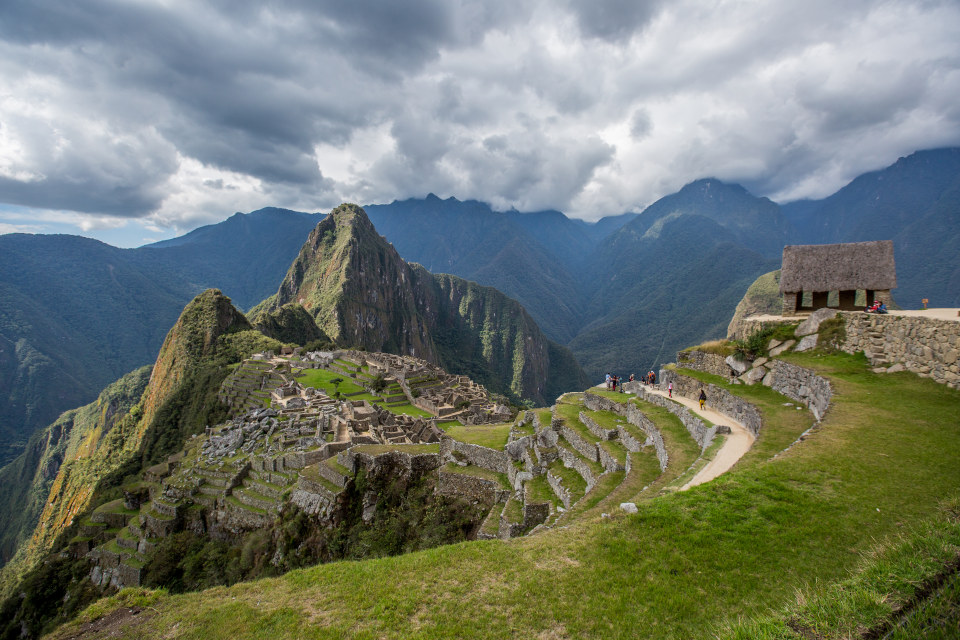
Machu Picchu citadel in Peru
Apart from the mystical and astrological significance of this incredible place, perhaps what is most fascinating about Machu Picchu is how well it was designed and constructed. The city is divided into two distinct sections: an agricultural zone and a more urban area. The bricks used for the approximately 150 buildings at the site were perfectly carved in such a way as to fit together without any kind of bonding agent. Additionally, the agricultural area features an ideal design with regards to irrigation. All of these and so many more reasons are why Machu Picchu is one of the most popular sites to visit in the entire world!
Tip for travelers: If you’re hoping to visit Machu Picchu, make sure you reserve your spot, as visits must be scheduled in advance and are limited to 4-hour blocks. A destination expert can help you with this process.
Throughout the world, there are several lakes that are found at very high altitudes above sea level. However, the highest of all of these and the largest on the continent of South America, is Lake Titicaca, located at 12,500 ft (3,810 m) above sea level. This incredible, freshwater lake extends 120 mi (almost 200 km) in a northwest-to-southeasterly direction and straddles the border between Peru and Bolivia in the southern part of the former country.
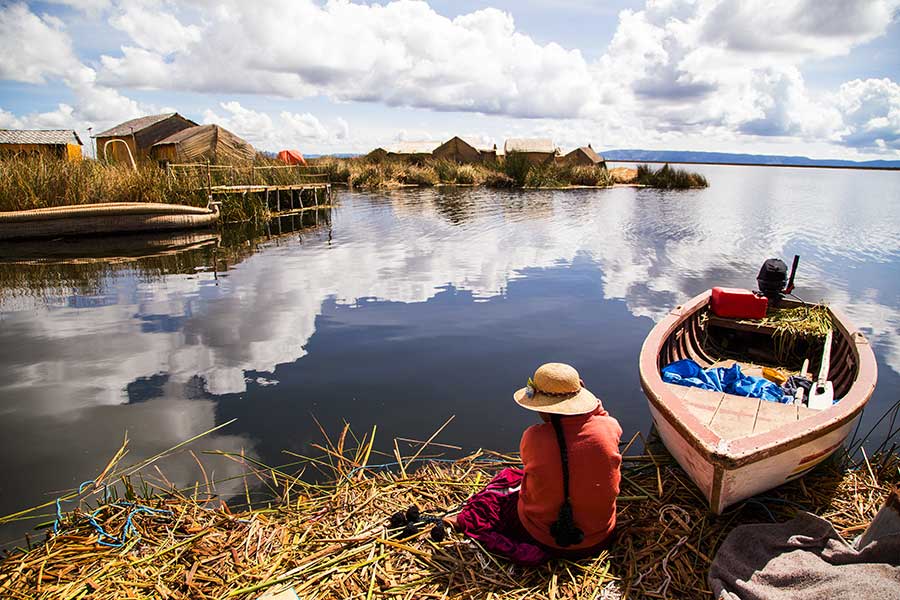
Floating islands of Uros in the Titicaca Lake, Peru
Along the perimeter of the lake are numerous and charming populated areas that are home to important, artful, and picturesque towns, rich in culture and tradition; none more exciting than Puno, whose lakefront activity represents a big part of its economy. Visitors to Puno can take any of several boat tours to the various islands of Lake Titicaca. Also, February is a great time to visit, as this is when the Virgen de la Candelaria Festival takes center stage with all of its pageantries.
Located in the Northwest corner of Peru is the town of Paracas. A coastal resort town with a large array of restaurants and beach-related activities. It is often compared to the Galapagos because of all the exciting wildlife that’s on display and, like the renowned archipelago, has similar red sands and blue waters that are protected by the Paracas National Reserve, which covers an area of over 87,000 ha (about 335,000 ac).

Geoglyph in Paracas, Peru
A trip to Paracas doesn’t just mean staying beachside. From here you can: sail alongside one of the famous and mysterious Nazca geoglyphs known as The Candelabra and, later, visit other fascinating Nazca lines by air. You can also tour the exciting sand dunes of Huacachina or take a tour of any of several pisco vineyards in nearby Ica. This is definitely a spot that’s well worth including on your itinerary through Peru.
At one point, Cuzco was the capital of the Incan Empire. The city, which serves as a gateway to Machu Picchu and the Sacred Valley, has a remarkable colonial history. The Spanish conquistadors stripped the Incan city of as much gold and silver as possible, destroyed its most prized monument, the Golden Temple of the Sun at Koricancha, and installed a church and convent (Santo Domingo) upon its remains. The resulting mix of cultures is felt in everything, from its cuisine to its cobblestone streets, numerous shops, and majestic landmarks.
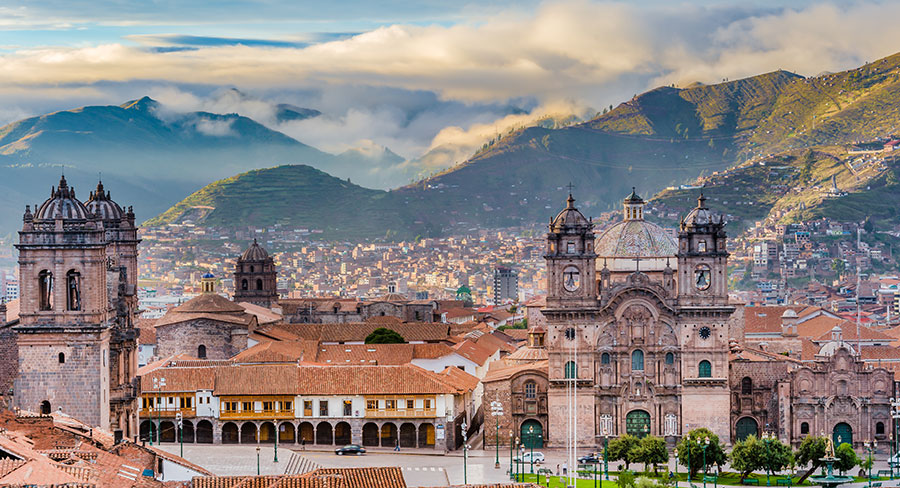
Cuzco City Skyline in Peru
Modern-day Cuzco is a favorite Peruvian site for many visitors, thanks in part to its eclectic San Blas neighborhood, which is full of art, music, cafés, and shops, along with its Plaza de Armas (a UNESCO World Heritage Site), myriad markets (including the popular San Pedro Market), interesting museums like the Centro de Textiles Tradicionales del Cusco (Traditional Textile Museum), and the Pre-Colombian Art Museum. All these things come together to form an all-around wonderful scenery. The best part is that you can base yourself out of Cuzco for a few days while making day trips to the Sacred Valley and surroundings.
With close to 9 million inhabitants, the capital city of Lima is the largest in Peru. It is situated along a central coastal plain that extends along three important river valleys and hosts numerous sites and activities for visitors to experience, not the least of which is the Historic Center, which features a convergence of Spanish-influenced architectural styles: Baroque, Neoclassical, and Colonial. It is also a frequently visited spot, due in part to its designation as a UNESCO World Heritage Site. Here, one can visit the Basilica and Convent of San Francisco, the Plaza Mayor (or Plaza de Armas), and the Torre Tagle Palace, to name a few.
Along the oceanfront, the popular Miraflores neighborhood is home to a uniquely-attractive shopping center, Larcomar, which boasts incredible ocean views given that it is carved into the side of a cliff overlooking the Pacific. From here, there are several spots and activities to see and do: surfing at Redondo or Waikiki beaches, walking along the pier and/or through Parque del Amor and, in the adjacent Barranco neighborhood: crossing the Puente de Suspiros (Bridge of Sighs) or visiting the relatively new and impressive Mario Testino Museum, or MATE, which promotes local artists and focuses on Peruvian heritage and culture. Additionally, the San Isidro neighborhood is just the place for you if you’re looking for boutique shops and elegant cafés.
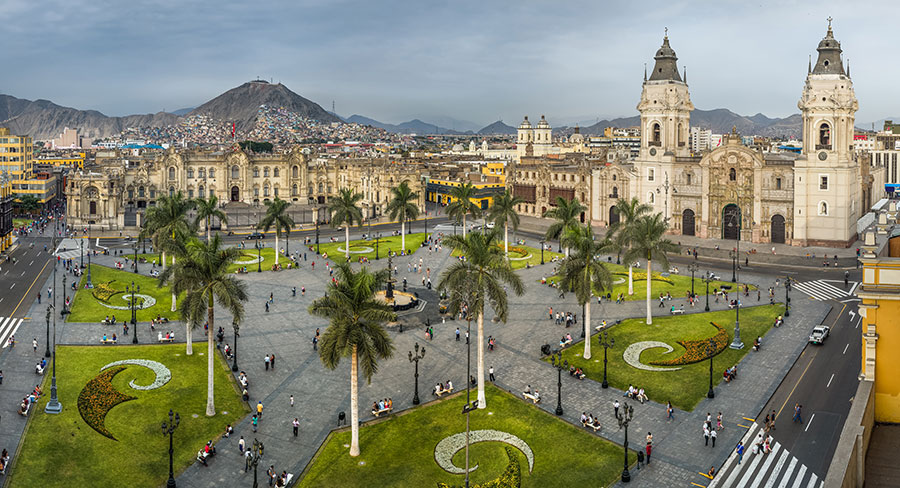
Lima’s main square, Peru
Lima is also renowned for its cuisine. A clever and tasty mix of traditional Andean flavors combined with Asian-influenced techniques makes for a very unique and popular culinary style. One can really enjoy exploring Peruvian gastronomy no matter where you dine, but the Barrio Chino is a huge favorite of many locals and visitors alike.
One of the most visited spots in all of Peru is the Sacred Valley, which extends to the northwest and southeast of nearby Cuzco. Just as its name implies, the Sacred Valley is home to some of the most important and impressive Incan ruins (Machu Picchu), as well as numerous other sites, equally worth visiting.
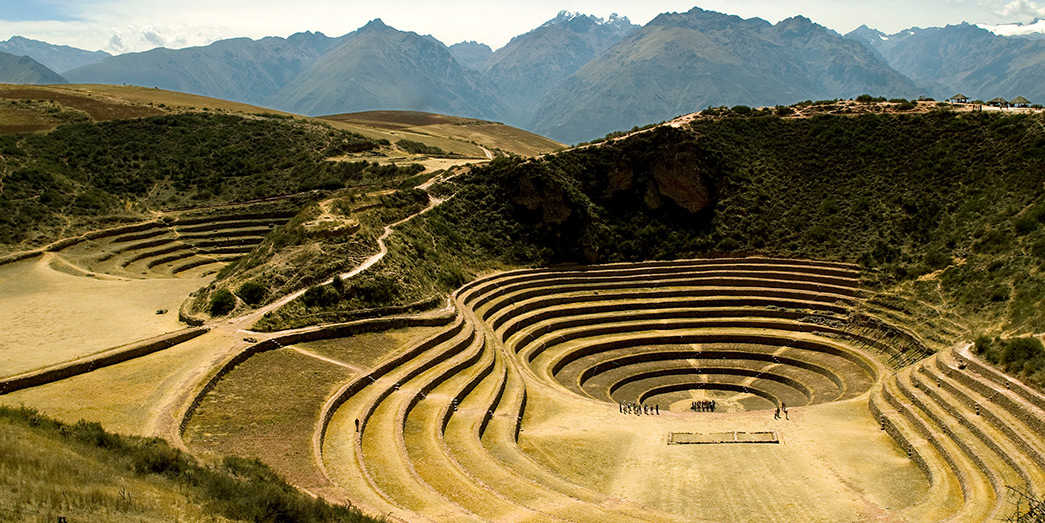
Sacred Valley in Peru
The Maras Saltpans, for instance, are among the most curious places to visit in the Sacred Valley. Here, a subterranean stream with a high level of salinity reaches a spring, where, in pre-Incan times, inhabitants of the area began redirecting the flow into a series of man-made saltpans, creating a set of pools in which the water, upon evaporating, yields this popular salt. The saltpans are a testament to the agricultural genius of the Peruvian people.
In the southeast corner of the valley, the town of Pisac is home to the colorful and popular Pisac Market, as well as the remarkably intact Pisac Ruins. The former is a colorful bazaar and an ideal spot to pick up authentic, handwoven garments and blankets. The latter is an incredible site that sits high above the town and features constructions that functioned as both living quarters and defensive outposts.
Towards the opposite side of the valley the town of Urubamba, which features some charming ceramics workshops, is host to festivals like El Señor de Torrechayoc, which features numerous, large and elaborate dance performances. Another notable spot in Urubamba is Quispiguanca, the ruins of Incan emperor Huayna Capac’s royal estate.
In Peru, much like other destinations around South America, there is no set standard or etiquette with respect to tipping. Depending on the place or establishment you visit, a tip may very well already be included in your bill next to the term “servicio” (service). This included tip is typically seen in mid- and high-end restaurants; with a tip percentage that usually hovers between 10-15% of the bill total. In these cases, it won’t be necessary to leave a tip; however, if you’re particular waiter or waitress was exceptionally helpful and cordial (or in the event this tip was not included in the bill), then you are more than welcome to leave between 3 and 6 soles (1 to 2 US dollars).
The same tipping recommendations can be followed when it comes to bellboys (typically per baggage piece handled), drivers, or cleaning services.
For tour guides, tipping will depend on the length of their service and how content you were with the tour they guided. We recommend leaving between 10 and 50 soles (3 and 15 dollars).
Who doesn’t love to take a great photo? Besides, Peru lends itself to being one of the most epic and fascinating subjects, thanks in large part to its rich landscapes and fascinating culture. Nevertheless, upon capturing images of adorable llamas or locals in traditional dress, it’s always a good idea to ask for permission. Some locals might not take too kindly to having foreigners take their picture without consent and, in some cases, might even ask for monetary compensation in return for their picture.
Upon hopping into a cab, shopping at small stores, artisanal markets or dining in small restaurants, be aware that large bills might not be accepted as readily. Preferably, such establishments will be delighted to be paid with smaller bills and/or coins, even. So it’s important that you carry these in your wallet, when possible! Alternatively, if you’re feeling generous, you can also let the sellers keep the change!
In Peru, it’s completely acceptable to try and lower the price that sellers (at artisanal markets) offer you and that taxi drivers present you with. On occasion, and more often with tourists than anyone else, these prices tend to “magically” escalate to nearly double or triple that price that their wares typically cost. That being said, if you feel that the price is excessive, you can always pull out those negotiating skills to try and get a better deal.
The higher up you are in terms of altitude, the closer you are to the sun. Therefore, you’ll need plenty of sunblock while in Peru! Don’t let a bad sunburn ruin your vacation in a destination as remarkable is this one! That’s why we recommend taking a sunblock with you that’s at least SPF50 or above.
Why stop in Peru? If you’re in the region, take advantage of your proximity to these other, exciting destinations!